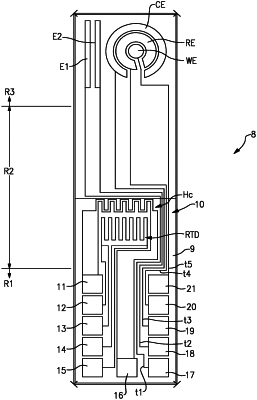| CPC G01N 27/07 (2013.01) [G01N 27/4166 (2013.01); G01N 33/18 (2013.01); G01N 27/302 (2013.01)] | 6 Claims |

|
1. A sensor assembly for water, the sensor assembly comprising:
an electrically non-conductive substrate; and
electrically conductive traces carried by the electrically non-conductive substrate, the electrically conductive traces comprising electrical circuits to sense a temperature of the water and a flow rate of the water,
wherein the electrical circuits comprise:
a temperature sensor circuit configured to determine the temperature of the water; and
a heater circuit configured to produce a temperature increase,
wherein a dissipation of the temperature increase is a function of the flow rate of the water passing the sensor assembly such that the dissipation is translated into the flow rate of the water, and
wherein the electrically conductive traces further comprise three electrodes to sense acidity (pH) of the water.
|